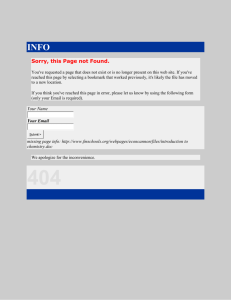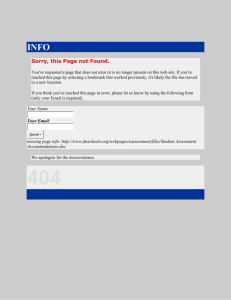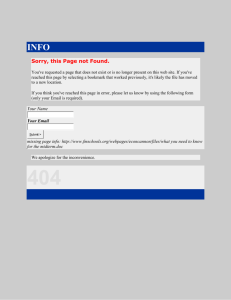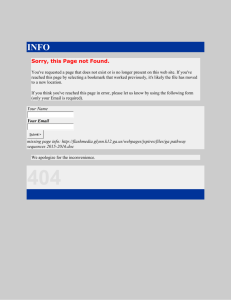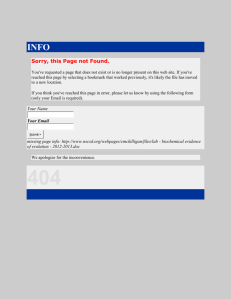Marketing plan template
advertisement
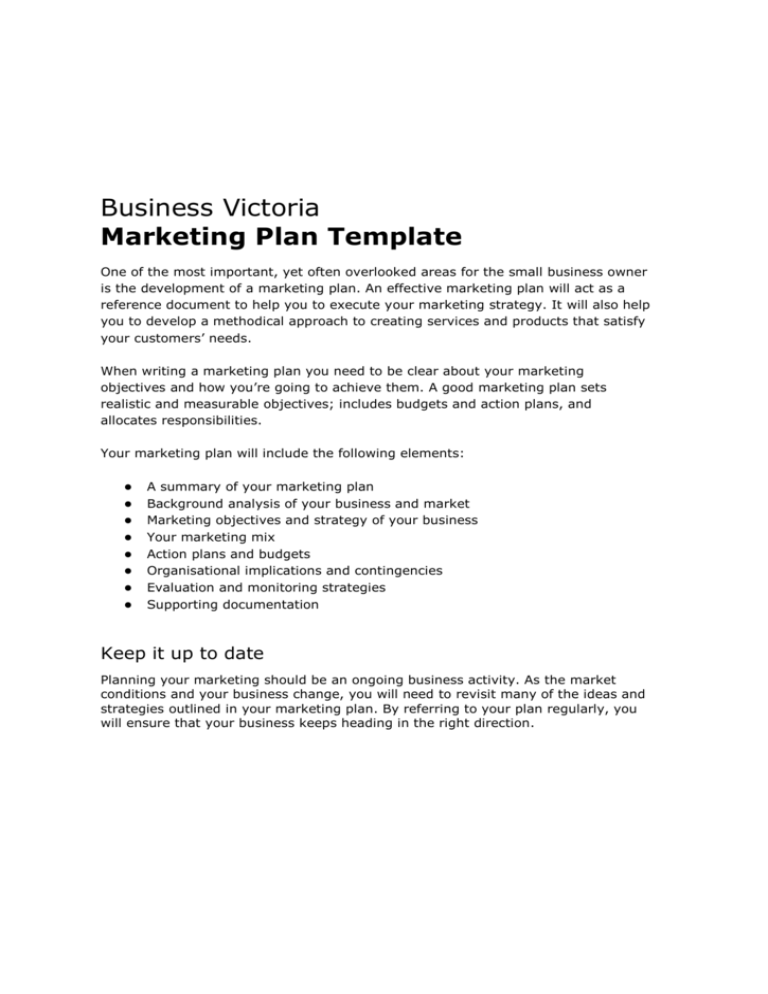
Business Victoria Marketing Plan Template One of the most important, yet often overlooked areas for the small business owner is the development of a marketing plan. An effective marketing plan will act as a reference document to help you to execute your marketing strategy. It will also help you to develop a methodical approach to creating services and products that satisfy your customers’ needs. When writing a marketing plan you need to be clear about your marketing objectives and how you’re going to achieve them. A good marketing plan sets realistic and measurable objectives; includes budgets and action plans, and allocates responsibilities. Your marketing plan will include the following elements: ● ● ● ● ● ● ● ● A summary of your marketing plan Background analysis of your business and market Marketing objectives and strategy of your business Your marketing mix Action plans and budgets Organisational implications and contingencies Evaluation and monitoring strategies Supporting documentation Keep it up to date Planning your marketing should be an ongoing business activity. As the market conditions and your business change, you will need to revisit many of the ideas and strategies outlined in your marketing plan. By referring to your plan regularly, you will ensure that your business keeps heading in the right direction. Business Victoria Marketing Plan How to use this template Prior to completing this marketing plan template, consider the following: 1. Gather together your key business documents. Before you begin, gather together your key business documents. This includes business plans, budgets, resumes, forecasts and registration documents. Having the right information on hand will mean you can be more accurate in your forecasts and analysis as you move through the marketing plan template. 2. Take your time and consider your specific needs. Work through the template at your own pace. Start by deciding which sections are relevant for your business and set aside the sections that don’t apply. You can always go back to the other sections at a later date. 3. Decide on your audience. It’s also important to consider your audience when writing your marketing plan. Will the plan be used internally? Or will you be sharing it with others? Deciding on the purpose of the plan can help you target your answers appropriately. 4. Use the [italicised text]. The italicised text is there to help guide you by providing some more detailed questions you may like to answer when preparing your responses. Of course, if a question does not apply to your circumstances it can be ignored. 5. Ask for some assistance. If you aren’t confident in completing the marketing plan template yourself, you can enlist the help of a professional (i.e. business adviser or accountant) to look through your plan and provide you with advice. 6. Write the Marketing Plan Summary last. The key with this section is to be succinct. You want to get to the point but not ignore important facts. The summary is a great opportunity to sell yourself and your business. You want anyone who reads you plan find it engaging, credible and easy to follow. 7. Review your work. Avoid mistakes by asking a number of impartial people to proofread your final plan. This way your marketing plan will make a great impression and be an inspiration for you when times are tough. 8. Print. The [italicised text] is instructional and will disappear on “preview print” or “print”. To print a copy, select the Printer icon on the toolbar, or select File then Print on the main menu. FORMATTING WILL NEED TO BE COMPLETED Page 1 [Business Name] Marketing Plan [YEAR] [INSERT YOUR BUSINESS LOGO] [Your Name] [Your Title] [Business Name] [Main Business Address] ABN: [ABN] ACN: [ACN] [Business Name] Marketing Plan Prepared: [Date prepared] Page 1 [Business Name] Marketing Plan [YEAR] Table of Contents Marketing Plan Summary ..................................................... 3 Your Business ............................................................................... 3 Market Overview ........................................................................... 3 Marketing Objectives ......................... Error! Bookmark not defined. Marketing Strategy ............................ Error! Bookmark not defined. Action Steps ..................................... Error! Bookmark not defined. Background Analysis ..................... Error! Bookmark not defined. Business overview ......................................................................... 5 Vision statement ............................... Error! Bookmark not defined. Mission statement ............................. Error! Bookmark not defined. Business objectives............................ Error! Bookmark not defined. Products/Services .............................. Error! Bookmark not defined. Financial Analysis .............................. Error! Bookmark not defined. S.W.O.T. analysis .......................................................................... 1 S.W.O.T. activity sheet................................................................. 19 Market Overview ........................... Error! Bookmark not defined. Your market...................................... Error! Bookmark not defined. Your customers/clients ....................... Error! Bookmark not defined. Your competitors ............................... Error! Bookmark not defined. Your Marketing ............................. Error! Bookmark not defined. Marketing objectives ...................................................................... 3 Marketing strategy ............................ Error! Bookmark not defined. 1........................................................................................................................ Product or Service ..................................................................... 3 2........................................................................................................................ Pricing ..................................................................................... 3 3........................................................................................................................ Positioning (or Place) ................................................................. 3 4........................................................................................................................ Promotion ................................................................................ 3 5........................................................................................................................ People ..................................................................................... 3 6........................................................................................................................ Processs .................................................................................. 3 7........................................................................................................................ Physical Environment ................................................................ 3 8........................................................................................................................ Productivity .............................................................................. 3 Marketing & Sales activity .................. Error! Bookmark not defined. Your Finances ..................................................................... 11 Marketing budget [YEAR].................... Error! Bookmark not defined. Organisational Implications ............................................... 11 Contingencies ..................................................................... 11 Monitoring/measurement activities ........... Error! Bookmark not defined. Supporting documentation ................................................. 19 Glossary ............................................................................. 23 Page 2 [Business Name] Marketing Plan [YEAR] Marketing Plan Summary [Please complete this page last] [The marketing plan summary is a snapshot of your more detailed answers from your marketing plan. It should be easy to read and simple to follow. ] Your Business Business name: [What’s your business registered business name? If you haven’t registered a business name, add your proposed business name here.] Business structure: [What’s the formal structure of your business? Are you a sole trader, in a partnership, a trust or company?] ABN: [What’s your registered Australian Business Number.] ACN: [What’s your registered Australian Company Number, if applicable.] Business location: [Where does your business operate from?] Date established: [When did you begin trading?] Business owner(s): [Who are the owners of the business?] Owner/s experience: [Create a brief summary of your (and other owner’s) experience in the industry and any major achievements/awards.] Products or Services: [What products and/or services do you sell?] Market Overview Target market: [In one or two sentences, summarise the key statistics for your target market. This may include the size and growth potential of your market, as well as key demographics such as age, gender, income level etc.] Customer profile: [What’s the profile of an ideal customer for your business? In one or two sentences, clearly define your ideal customer - their needs, buying patterns and motivations for buying.] Competitor profile: [What’s the profile of a typical competitor for your business? What marketing mix do they use? Have you identified any gaps in their marketing strategy?] Marketing Objectives Goals/objectives: [In one or two sentences, summarise the key marketing objectives for your business. Your objectives may be financial, with a goal to increase sales, or marketing focused to build awareness of your product or service.] Marketing Strategy Your strategy and marketing mix: [Use this section to summarise the overall strategy and marketing mix (The 8 P’s) you will use to position yourself within the market to meet your customers’ Page 3 [Business Name] Marketing Plan [YEAR] needs. Whatever your strategy, you goal should be to differentiate yourself from your competitors to encourage customers to choose your business first.] Action Steps Top 10 Action Steps: [Create a list of the Top 10 action steps that will bring your theoretical objectives (your marketing strategy and objectives) to life. E.g. Finish S.W.O.T. Activity Sheet, complete marketing budget] Page 4 [Business Name] Marketing Plan [YEAR] Background Analysis The background analysis should give a snapshot of where you are right now, where you have been and where you want to go. Undertaking this process will help you to define your business's capabilities and find opportunities within your particular market. Finally, defining your core business elements will ensure that your marketing plan and overall business strategy work together seamlessly. Business overview [The overview should cover the nuts and bolts of your business including: The name, structure and date of establishment Details about the owners (their names, roles and levels of experience etc.) What your business is about (your business mission, vision and values) The key business objectives you would like to achieve An outline of the main products and services sold A financial analysis of your business including sales and profitability A S.W.O.T. analysis of your business to set a line in the sand] Business name: [What’s your business registered business name? If you haven’t registered a business name, add your proposed business name here.] Business structure: [What’s the formal structure of your business? Are you a sole trader, in a partnership, a trust or company?] ABN: [What’s your registered Australian Business Number.] ACN: [What’s your registered Australian Company Number, if applicable.] Business location: [Where does your business operate from?] Date established: [When did you begin trading?] Business owner(s): [Who are the owners of the business?] Owner/s experience: [Create a brief summary of your (and other owner’s) experience in the industry and any major achievements/awards.] Vision statement: [A Vision statement should describe WHERE you want your business to be in the future. It should communicate both the PURPOSE and VALUES of your business and answer the question, “Why are we here?”] Mission statement: [A Mission statement should outline HOW you will get to where you want your business to be in the future (Your Vision). It should define the PURPOSE and PRIMARY OBJECTIVES of your business and answer the question, “What do we do?”] Business objectives: [What are your short and long term goals for your business?] Short Term: [What are three primary short-term goals for your business (6 Months)?] Goal/Objective Description By when [Goal/Objective name] [Brief goal/objective description] [Date of completion] Page 5 [Business Name] Marketing Plan [YEAR] Long Term: [What are three primary long-term goals for your business (1-3 Years)?] Goal/Objective Description By when [Goal/Objective name] [Brief goal/objective description] [Date of completion] Products: [What products and/or services do you sell?] Product/Service Description Price [Product/service name] [Brief product/service description] [Unit price including GST] Financial Analysis: [In this section provide a high level analysis of your current financial situation, specifically addressing sales and profitability.] Part 1 – Sales Analysis Use this section to summarise the current sales data for your industry (if available) and your business. The areas that you can analyse include: • Sales for your overall market • Sales for your business • Sales for your competitors If you wish to dig deeper, you can expand the analysis to Sales by Product Categories, Sales By Distribution Channels and Sales By Geography. Part 2 – Profitability Analysis Use the sales numbers above to identify realised revenues rather than just projections and then breakdown marketing expenses in terms of direct (expenses directly tied to products) and indirect or proportional (general administrative or broad marketing expenses). Page 6 [Business Name] Marketing Plan [YEAR] S.W.O.T. analysis [Use the table below to list each of your businesses Strengths, Weaknesses, Opportunities or Threats (S.W.O.T.).] Strengths Weaknesses Opportunities Threats Page 1 [Business Name] Marketing Plan [YEAR] S.W.O.T. activity sheet [Outline how and when you plan to address each of the weaknesses/threats from your S.W.O.T. analysis above.] S.W.O.T weakness/ threat Activity to address weakness/threat Page 2 Completion date [Business Name] Marketing Plan [YEAR] The Market Overview Gathering information and identifying the key characteristics of your target market will help you to find the most effective way to reach your target customers. The Market Overview should provide an analysis of the market in which your business operates, including your customers, competitors and the market as a whole. Revisit this process regularly to ensure that your strategy remains relevant and targeted. Your Market Target market: [Summarise the key statistics for your target market. This may include the size and growth potential of your market, as well as key demographics such as age, gender, income level etc.] Market research and environmental/industry analysis: [What research have you completed to help analyse your market? Did you utilise a survey/questionnaire? If so, you may like to attach a copy of your survey/questionnaire and findings to the back of this plan. In this section, detail the results of the market research you have performed. Consider questions such as: Is the area experiencing population growth or decline? Does the region where you operate have a stable economy? Are there any seasonal variations that might affect sales? What is the size of the market? What recent trends have emerged in the market? Is there potential for growth in the market? How will you be able to capitalise on any opportunities? How will your entrance affect the market/customers? What external factors will affect your customers? Click here for more information on DIY Market Research ] Page 3 [Business Name] Marketing Plan [YEAR] Your Customers Target customers: [Who are your target customers and how do they behave? Include specific demographics such as age, social status, education and gender. What are your customers’ lifestyles, activities, values, needs, interests or opinions? Where are they located? Please adjust the column headings as required.] Customer Age Gender Ethnicity Education Location Lifestyle Values Interests [Target customer – choose a name] [Customer’s Age] [Customer’s Gender] [Customer’s ethnic background] [Customer’s education level] [Customer’s location] [Customer’s lifestyle] [Customer’s values] [Customer’s interests] Customer profile: [What’s the profile of an ideal customer for your business? In a paragraph or two, clearly define your ideal customer - their needs, buying patterns and motivations for buying. This process will help you to develop a mental image of your ideal customer (often referred to as a customer avatar).] Page 4 [Business Name] Marketing Plan [YEAR] Your Competitors Competitor analysis: [Use the table below to analyse at least 5 competitors.] Competitor Established date Size Market share (%) Value offered to customers Strengths Weaknesses [Competitor’s name] [When was their business established?] [Number of staff and/or turnover] [Estimated percentage of market share] [Unique value to customers, e.g. quality, price or customer service?] [What are your competitor's main strengths?] [What are your competitor's main weaknesses?] Competitor profile: [What’s the profile of a typical competitor for your business? In a paragraph or two, clearly define a typical competitor their size, market share, unique value proposition, strengths and weaknesses. This process will help you to develop a mental image of your typical competitor.] Page 5 [Business Name] Marketing Plan [YEAR] Your Marketing Marketing Objectives: [Summarise the key marketing objectives for your business. Your objectives may be financial, with a goal to increase sales, or marketing focused, to build awareness of your product or service. An effective (and accountable) way to define your marketing objectives is to follow the ‘SMART’ acronym (Specific, Measurable, Achievable, Realistic and Timely)1. Examples of SMART marketing objectives ● ● ● To achieve a 20% return on capital employed by April 2014 (Profitability Objective) To gain 15% of the market for sports socks by November 2018 (Market Share Objective) To make X brand of juice the preferred brand of 21-29 year old females in Australia by August 2019 (Branding Objective) Detail your SMART marketing objectives in the table below:] 1 Objective Specific Measurable Achievable Realistic Timely [Your specific marketing objective] [Is your objective specific?] [Can your objective be measured?] [Is your objective achievable?] [Is your objective realistic?] [Have you set a specific date for your objective to be achieved?] Doran, G. T. (1981). There's a S.M.A.R.T. way to write management's goals and objectives. Management Review, Volume 70, Issue 11(AMA FORUM), pp. 35-36. Page 6 [Business Name] Marketing Plan [YEAR] Marketing Strategy: [Use this section to detail the overall strategy you will use to position yourself within the market to meet your customers’ needs. Whatever your strategy, you goal should be to differentiate yourself from your competitors to encourage customers to choose your business first. The specific elements that make up your marketing strategy are typically referred to as the marketing mix. Each element can be varied to broaden the appeal of products and services, and will therefore have a direct impact on sales. The 8 P's of marketing 1 2 3 4 5 6 7 8 Your PRODUCT (or SERVICE) The PRICING of your product or service Your POSITION (place) in the marketplace The PROMOTION of your product of service The PEOPLE in your business (salespeople, staff etc.) [link] The PROCESS represents the buying experience [link] The PHYSICAL environment where the good/services are presented [link] PRODUCTIVITY and Quality is an essential part of meeting customer needs [link] Click any of the links above to find out more about a specific element and how it can be applied.] Page 7 [Business Name] Marketing Plan [YEAR] 1. Your PRODUCT (or SERVICE) [Here you should describe your long-term product strategy in detail. If you are providing a service then you should consider your service(s) as your product(s). You will need to consider: What features and benefits do you offer? The unique selling position - what makes your product/service different from your competitors’? Potential spin-off products or services?] Product or Service Features Benefits Unique Selling Position Support Spin Offs [What is your product or service?] [What are the features of your product or service? [What are the customer benefits of your product or service?] [What makes your product or service unique?] [What additional support do you offer? E.g. warranty, money back etc.] [Are there any potential spin-off products or services you can offer?] Page 8 [Business Name] Marketing Plan [YEAR] 2. The PRICING of your product or service [Price is a critical component of your marketing mix. Why? Because choosing the right price for your products or services will help you to maximise profits and also build strong relationships with your customers. By pricing effectively you will also avoid the serious financial consequences that can occur if you price too low (not enough profit) or too high (not enough sales). Setting prices for your products and services might seem like a daunting task, however, it doesn’t need to be … just remember: you are in business to make a profit (and that’s ok!) most business owners underprice the value that they deliver your sales and marketing strategy should defend your prices Your overall pricing strategy will depend on your marketing, business and lifestyle objectives. So, before you start the research process spend some time defining your income (and net profit) aspirations. Also take a look at the small business expected income benchmarks on the ATO website.] Product or Service Price Costs Net Profit Comp. Price Value [What is your product or service?] [What is the price of your product or service?] [What is the total cost of selling your product or service?] [What Net Profit is made from selling your product or service?] [What is your competitor’s pricing for this product or service? [What unique value does your product or service offer/deliver?] Page 9 [Business Name] Marketing Plan [YEAR] 3. Your POSITION (Place) in the marketplace [Place refers to the channels and locations for distributing your product, related information, and support services. This is how you will position your product or service in the marketplace. This includes: the place where the product/service can be bought; the distribution channel; Place represents the location where a product can be purchased. It is often referred to as the distribution channel. This may include any physical store (supermarket, departmental stores) as well as virtual stores (e-markets and e-malls) on the Internet. This is crucial as this provides the place utility to the consumer, which often becomes a deciding factor for the purchase of many products across multiple product categories.] Sales and distribution channels Channel type Products/services Percentage of sales (%) Distribution strategy [e.g. Shopfront, internet, direct mail, export or wholesale.] [List all the products/services sold via this channel] [What percentage of overall sales do you expect to sell via this channel?] [Why have you decided to use this channel type? How and when will you use it? What is the strategy behind using this channel type for this particular product/service?] Page 10 [Business Name] Marketing Plan [YEAR] 4. The PROMOTION of your product or service [State how you currently promote and market your business now (or intend to). Compare (where applicable) what your competitors do for promotion, noting what does and doesn’t work for them as well as yourself. Regardless of how good your business is, if you don’t promote it and tell people you exist, it’s unlikely you will make many sales. Promotion is more than selling and advertising your business. It’s about attracting the right people to use and reuse your business. There are a number of techniques to use and they can be combined in various ways to create the most cost effective strategy for your needs. Detail your promotion techniques into six categories: online public relations advertising promotion packaging or personal selling branding direct marketing is often added to the marketing mix despite being part of advertising rather than marketing. ] Product or Service Online Public Relations Advertising Promotion Packaging Branding [What is your product or service?] [What online strategies are you using?] [What PR strategies are you using? [What advertising strategies are you using?] [What promotion strategies are you using?] [What packaging strategies are you using?] [What branding strategies are you using?] Page 11 [Business Name] Marketing Plan [YEAR] 5. The PEOPLE in your business (salespeople, staff etc.) [Every employee in your business (if you have them) can influence the marketing of your products and services. Knowledgeable and friendly staff can contribute to creating satisfied customers, and can provide the unique selling experience that an organisation is often seeking. If an outstanding team provides a competitive advantage, then the quality of recruitment and training becomes essential to achieving your marketing objectives. Some questions to consider when assessing your team members: Are they prepared to talk with clients in detail about your products and services? Do you have training in place to drive constant improvement? Do your team understand the process for handling client interactions? Are staff members empowered to make decisions (and act) on the business’s behalf? Do they have the communication skills to be effective? Do staff members ‘live’ your brand when they are at work?] Name Job Title Department Responsibilities [Mr Chris Brantley] [e.g. Marketing/ Sales Manager] [e.g. Sales] [What are the main responsibilities of this position?] Page 12 [Business Name] Marketing Plan [YEAR] 6. The PROCESS represents the buying experience [Process represents the buying experience that the customer experiences when they buy your product or service. For example, the way that a fine bottle of wine is presented and served in a restaurant, the reaction of a business to a complaint or the speed of delivery in a fast food outlet. A poor process, on the other hand, can undermine the other elements of the marketing mix. Budget airlines, for example, may offer very competitive headline prices, but if the final price is inflated by additional charges such as baggage charges and administrative fees, customers may begin to feel that they have been taken advantage of even if the final price is lower than other carriers.] Product or Service The Process Key Benefits Improvements [What is your product or service?] [Outline the Process in point form] [What are the key benefits for the customer?] [What changes can you make to improve the Process?] Page 13 [Business Name] Marketing Plan [YEAR] 7. The PHYSICAL ENVIRONMENT where the good/services are presented [The physical environment where your products or services are sold and delivered can have a significant impact upon how your customers experience your business. The physical environment represents the tangible aspects of selling your products and services, such as the quality of the furnishings in your consulting rooms or the design of your reception area. Creating a positive physical environment doesn’t have to be costly – a vase full of fresh flowers can make a big difference. Use the table below to outline the physical environments that your customers experience when they buy your products or services and any improvements you might be able to make.] Name Selling Environment Delivery Environment Improvements [What is your product or service?] [Where is the product or service sold?] [Where is the product or service delivered?] [What changes can you make to improve the Physical Environment?] Page 14 [Business Name] Marketing Plan [YEAR] 8. PRODUCTIVITY is an essential part of meeting a customer’s needs [Improving productivity is an important factor in cost management; however, it also plays a key role in satisfying customer’ needs. The more effective and efficient your marketing efforts are the more satisfied customers your business will create at a lower cost. Here are some examples of strategies that could improve your marketing productivity: Improved Marketing Accounting – take time to understand where resources are being spent, customer value being created and where money is being made or lost. Marketing Alliances – share resources, ideas and opportunities with other organisations that service the same customers. Encourage Customer Involvement – increase customer satisfaction and lower costs by adding customers to the value chain e.g. ask them to write guest posts for your blog.] Name Job Title Department Responsibilities [Mr Chris Brantley] [e.g. Marketing/ Sales Manager] [e.g. Sales] [What are the main responsibilities of this position?] Page 15 [Business Name] Marketing Plan [YEAR] Marketing Activity [Once you have defined your marketing mix, the next step is to detail the specific activities that you will undertake to achieve your marketing objectives. As you create these activities, keep referring back to your marketing mix – it will help you to assess which activities are worth the time and effort to implement. What steps or activities will you undertake to achieve your marketing objectives?] Marketing activity/milestone Person responsible Date of expected completion Cost ($) Success indicator [Print advertising, online advertising, mail-out, giveaway, media release, event, website, blog/social media, public relations, branding and artwork, or publications and catalogues.] [Who is responsible for completing this task?] [When do you expect to complete the marketing activity?] [Estimated cost of activity.] [What indicator/ measurement result will need to be met before this activity is considered a success?] Page 16 [Business Name] Marketing Plan [YEAR] Your Finances Marketing Budget [YEAR] [To complete this marketing budget, you should rely heavily on your financial statements and projections. Double-click the table below to enter your details or attach your own budget at the back of this marketing plan.] Page 17 [Business Name] Marketing Plan [YEAR] Item Jan Feb Mar Apr May Jun Jul Aug Sep Oct Nov Dec Marketing/promotion Marketing agency Radio advertising Television advertising Print advertising Online advertising Social media Web search optimisation Mailouts Giveaways Events Branding & artwork Merchandising Publications Catalogues More… Marketing/ promotion total $0.00 $0.00 $0.00 $0.00 $0.00 $0.00 $0.00 $0.00 $0.00 $0.00 $0.00 $0.00 Other Research Travel Postage Administration Incidentals More… Other total $0.00 $0.00 $0.00 $0.00 $0.00 $0.00 $0.00 $0.00 $0.00 $0.00 $0.00 $0.00 Total $0.00 $0.00 $0.00 $0.00 $0.00 $0.00 $0.00 $0.00 $0.00 $0.00 $0.00 $0.00 Page 18 [Business Name] Marketing Plan [YEAR] Organisational Implications [Organisational implications are often overlooked when business owners tackle a marketing plan. For example, if your goal is to increase your customer base by 15% and therefore your staff by 10% - will you be able to house them in your current offices? Could you outsource some tasks? It’s important to consider and document these decisions in your plan. Use the space below to outline any organisational implications, which you feel may affect the implementation of your marketing plan.] Page 19 [Business Name] Marketing Plan [YEAR] Contingencies [All plans in business should remain flexible (and adjustable) as you are often working with assumptions. The more planning you do, the better you will become at predicting. However, as you are learning the needs of your market - it is fair to say that some of your assumptions are going to fall short of expectation. Use the space below to outline any contingencies (alternative options) which may assist if things don’t go as planned.] Page 20 [Business Name] Marketing Plan [YEAR] Monitoring/measurement activities [Reviewing the impact of your marketing should be a periodic activity. List the details of each review in the table below.] Marketing activity Date of review Monitoring methods Review outcomes [Print advertising, online advertising, mail-outs, giveaways, media releases, events, website, blog/social media, public relations, branding and artwork, or publications and catalogues.] [e.g. Month/Year] [What tools did you use to measure/monitor the impact of your marketing activities?] [e.g. What were the results for the promotional period? What were your sales/profit figures? How many new/repeat customers did you receive? How many customers visited your website? Etc.] Page 21 [Business Name] Marketing Plan [YEAR] Supporting documentation [Attach any supporting documentation in relation to this marketing plan. List all of your attachments here. These may include resumes, customer survey/questionnaire and/or financial documents.] Page 22 [Business Name] Marketing Plan [YEAR] Glossary Australian Business Number (ABN) – a single identifying number used when dealing with other businesses and the Australian Tax Office. Australian Company Number (ACN) – the number allocated by the Australian Securities and Investments Commission (ASIC) when you register a company under the Corporations Law. Blog –is a shortened word for Weblog (see Weblog). Channel – a way of delivering something to its destination, whether it is a message to be communicated or a physical product to be delivered. Contract – a legally enforceable agreement made between two or more parties. A contract may be a verbal contract or a written contract (or may be partly verbal and partly written). Demographics – the characteristics of a population or segment of the population, commonly examined demographics include age, gender, ethnicity, knowledge of languages, employment status, mobility and geographic location. Domain name – an identification string (name) that identifies an organisation's address on the internet, either a website address or an email address. Domain names are formed by the rules and procedures of the Domain Name System (DNS). Click here for more information Goods and Services Tax (GST) – a broad-based tax of 10 per cent on the sale of most goods and services in Australia. High-end – usually refers to expensive or high quality products/services. Market position – refers to the position an organisation, product or service has in the market, usually in relation to its competition. Milestone – a goal or objective with a target date. Mission statement – is a statement (usually internally facing) which outlines how a business (organisation) intends to achieve its Vision. It should define the PURPOSE and PRIMARY OBJECTIVES of the business and answer the question, “What do we do?” Social media – a group of technology including Blogs, online networks (e.g. Twitter, Facebook, MySpace, LinkedIn) and online collaboration tools often used to expand your network/market reach or collaborate on a large scale. Unique selling position – a characteristic of a business or a product/service that sets it apart from the competition. Vision statement – is a statement (usually public facing) which outlines where a business (organisation) wants to be in the future. It should communicate both the PURPOSE and VALUES of the business and answer the question, “Why are we here?”. Weblog – (also known as a Blog) an individual's or organisation's online website displaying a reverse-chronological list of entries (known as posts). Posts typically include thoughts, observations, promotions, links, images or videos. A Weblog is publically available and allows readers to comment on posts. Page 23
